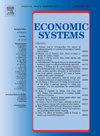The impact of Russia’s Geopolitical Risk on stock markets’ high-moment risk
IF 2.8
2区 经济学
Q1 ECONOMICS
引用次数: 0
Abstract
We investigated the time and frequency connectedness between Russia’s geopolitical risk (R-GPR) and the high-order moments (volatility, skewness, and kurtosis) of equity markets in eight countries: U.S., Belgium, France, Germany, U.K., Italy, Switzerland, and Spain. Our findings showed that R-GPR and realized volatility co-move in the short- and medium-term frequency bands during wartime, except in the U.S. and U.K. markets. Concerning realized skewness, significant co-movements were observed between R-GPR and Belgium and Germany during the short- and medium-frequency bands, implying that higher skewness (crash risk) was associated with higher R-GPR. Contrastingly, the realized kurtosis and R-GPR were connected at a long-term frequency. Finally, R-GPR negatively led to realized kurtosis in the U.S. market, implying the U.S. market’s hedging potential for fat-tail risk. Our results provide essential insights into the investment and risk-management practices of market participants with different investment horizons.
俄罗斯地缘政治风险对股市高风险的影响
我们研究了俄罗斯地缘政治风险(R-GPR)与八个国家股票市场的高阶时刻(波动性、偏度和峰度)之间的时间和频率联系:美国、比利时、法国、德国、英国、意大利、瑞士和西班牙。我们的研究结果表明,在战争期间,除了美国和英国市场,R-GPR和实现波动率在中短期频带共同移动。在实现偏度方面,在中短频段,R-GPR与比利时和德国之间观察到显著的协同运动,这意味着较高的偏度(碰撞风险)与较高的R-GPR相关。相比之下,实现峰度与R-GPR在一个长期频率上连接。最后,R-GPR负向导致美国市场实现峰度,暗示美国市场对肥尾风险的对冲潜力。我们的研究结果为具有不同投资视野的市场参与者的投资和风险管理实践提供了重要的见解。
本文章由计算机程序翻译,如有差异,请以英文原文为准。
求助全文
约1分钟内获得全文
求助全文
来源期刊

Economic Systems
ECONOMICS-
CiteScore
4.90
自引率
0.00%
发文量
83
审稿时长
48 days
期刊介绍:
Economic Systems is a refereed journal for the analysis of causes and consequences of the significant institutional variety prevailing among developed, developing, and emerging economies, as well as attempts at and proposals for their reform. The journal is open to micro and macro contributions, theoretical as well as empirical, the latter to analyze related topics against the background of country or region-specific experiences. In this respect, Economic Systems retains its long standing interest in the emerging economies of Central and Eastern Europe and other former transition economies, but also encourages contributions that cover any part of the world, including Asia, Latin America, the Middle East, or Africa.
 求助内容:
求助内容: 应助结果提醒方式:
应助结果提醒方式:


